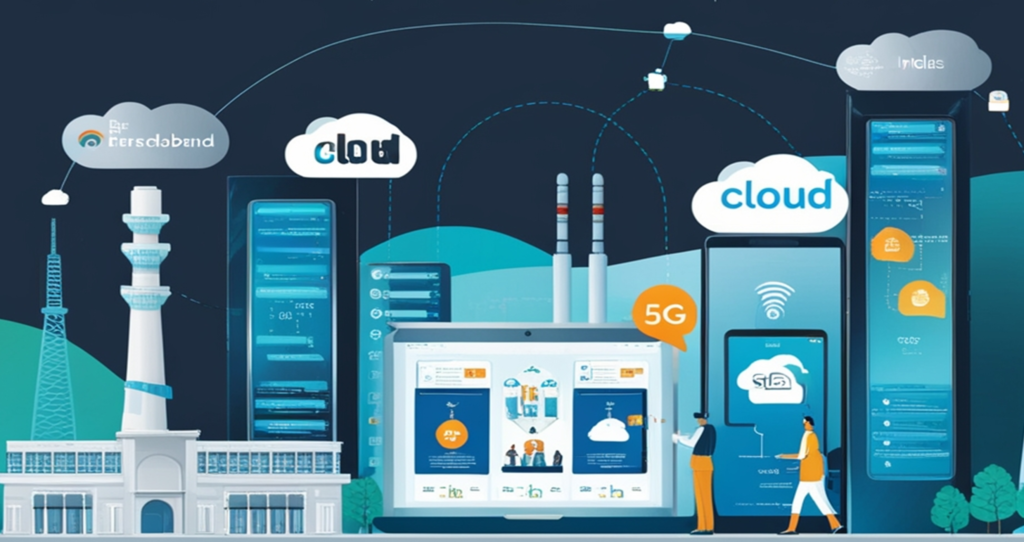
The Telecom Industry of India – A Drive from 2G to 5G
The telecom industry has been the backbone of global connectivity, evolving dramatically over the past few decades. In India, it has been a key driver of technological advancements, with innovations that have transformed not only how businesses operate but also how individuals communicate.
This journey from 2G to 5G, coupled with significant developments like the shift from PRI to SIP Trunk, the emergence of fibre optics, and the rapid adoption of cloud solutions, marks a revolution that is redefining India’s telecom landscape.
From 2G to 5G: A Leap in Connectivity
The telecom revolution in India truly began with the advent of 2G technology in the early 1990s. 2G brought mobile phones into the hands of millions, enabling basic voice calls and text messaging. It was the first step towards a connected India, providing affordable, widespread communication.
Then came 3G, which introduced mobile data and opened up new possibilities like video calls, mobile internet, and multimedia sharing. This era brought mobile internet to the masses, laying the foundation for more advanced services. However, it was 4G that truly transformed the digital ecosystem in India. The advent of 4G networks, led by companies like Reliance Jio, revolutionized internet speeds, making data-heavy applications, video streaming, and mobile commerce part of daily life for millions of users.
Now, the country stands on the brink of another breakthrough with 5G. The promise of 5G goes beyond just faster internet speeds. With ultra-low latency, enhanced capacity, and the ability to connect billions of devices simultaneously, 5G is poised to revolutionize industries such as healthcare, manufacturing, and transportation. It will enable the Internet of Things (IoT) to become a reality, with smart cities, autonomous vehicles, and connected healthcare becoming possible. For businesses, 5G will be a game-changer, offering unmatched bandwidth and network reliability.
The Shift from PRI to SIP Trunk: Modernizing Voice Communication
In parallel with the advancements in mobile networks, the telecom industry has seen a significant transformation in business communication. Traditionally, businesses relied on Primary Rate Interface (PRI) lines for voice communication, which provided multiple voice channels over a single physical line. While effective, PRI was limited in terms of scalability and cost-effectiveness.
Enter Session Initiation Protocol (SIP) Trunk. SIP trunks allow voice communication to be transmitted over data networks, eliminating the need for separate voice lines. This shift has enabled businesses to consolidate their voice and data communications, significantly reducing costs and improving scalability. With SIP, enterprises can easily increase or decrease their number of lines based on demand, and it also offers more flexibility in terms of geographic reach.
For enterprises in India, the transition from PRI to SIP Trunk has streamlined operations and paved the way for more efficient, reliable, and scalable communication solutions. It has also laid the groundwork for the integration of voice services with other digital platforms, like unified communications and video conferencing.
From 1Mbps Leaselines to Fibre Broadband: The Era of High-Speed Connectivity
The era of 1Mbps leased lines for enterprise connectivity was a defining moment in the early days of the telecom revolution. Leased lines, which provided a dedicated, reliable internet connection, were essential for businesses to operate effectively, especially for those with critical applications and inter-office communication needs. However, these connections came with limited bandwidth, which constrained the growth of data-heavy applications.
With the rollout of fibre optic networks, businesses have experienced a quantum leap in connectivity. Fibre broadband offers unparalleled speed, reliability, and bandwidth, making it ideal for modern-day enterprises. From video conferencing to cloud computing, fibre-based business broadband and high-speed leased lines are now the lifeblood of businesses in India.
Today, dedicated high-speed leased lines of 1Gbps or more are standard for large enterprises, ensuring seamless data transmission, critical for sectors like banking, healthcare, and IT. Small and medium-sized enterprises (SMEs) also benefit from the widespread availability of high-speed broadband, enabling them to compete on a level playing field.
The Cloud: Transforming Enterprise IT Infrastructure
The evolution of the telecom industry has also fueled the adoption of cloud computing. For enterprises, the cloud has shifted the paradigm of IT infrastructure. In the past, businesses needed to invest in expensive servers, hardware, and IT support to manage their operations. Now, with cloud services becoming more accessible and affordable, businesses can leverage scalable, on-demand resources without the overhead of managing physical infrastructure.
Cloud solutions offer enterprises greater flexibility, security, and cost efficiency. From cloud-based storage to SaaS (Software as a Service) platforms, Indian businesses have embraced the cloud to streamline operations, improve collaboration, and enable remote work. The cloud is also integral to leveraging big data, AI, and machine learning, which are rapidly becoming the drivers of innovation in industries such as retail, finance, and healthcare.
The Future of Telecom in India
As the telecom industry continues to evolve, India is poised to be a leader in this revolution. The rollout of 5G, combined with the expansion of fibre broadband and cloud solutions, will further empower businesses to innovate and grow. Enterprises will increasingly rely on these technologies to drive digital transformation, optimize operations, and enhance customer experiences.
The shift from PRI to SIP and from 1Mbps leased lines to high-speed fibre connections demonstrates how the industry has continually adapted to meet the changing demands of businesses. With ongoing advancements in telecom, India is set to enter a new era of connectivity, where businesses can operate faster, smarter, and more efficiently than ever before.
Conclusion
In conclusion, the telecom industry in India has come a long way from the days of 2G and 1Mbps leased lines. Today, we are at the forefront of a digital revolution with 5G, SIP Trunking, fibre broadband, and cloud computing leading the way. The future promises even more exciting developments, as telecom continues to shape the way we live, work, and communicate.